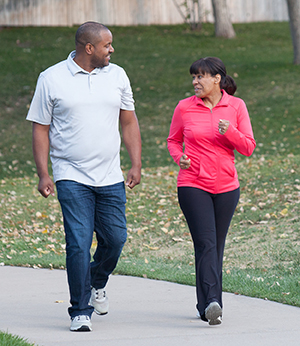A Walking Program for Peripheral Arterial Disease (PAD)
Peripheral arterial disease (PAD) is a condition where the arteries in the legs are severely damaged. When you have PAD, walking can be painful. So you may start to walk less. Walking less makes your leg muscles weaker. It then becomes harder and more painful to walk. A walking program can break this cycle. Here's how to get started.

Walking farther without pain
Exercise strengthens leg muscles that are out of shape. It also trains these muscles to work with less oxygen. This helps your leg muscles work better even with reduced blood flow to your legs. When you have PAD, a walking program can be helpful. Your program can:
-
Help you walk longer and farther without claudication. This is an ache in your legs during exercise that goes away with rest.
-
Let you do more and be more active
-
Add to your overall health and well-being
-
Help you control your blood sugar and blood pressure
-
Help you become healthier with no risk and at little or no cost
Getting started
Your local hospital, vascular center, or cardiac rehab center may have a special walking program for people with PAD. If so, this is your best option. But if you can’t find a program, or it’s not covered by insurance, you can still walk on your own. Follow these steps at each session:
-
Step 1. Start at a pace that lets you walk for 5 to 10 minutes before you start to feel claudication. This feeling is unpleasant, but it doesn’t hurt you. Keep going until the pain makes you feel that you need to stop.
-
Step 2. Stop and rest for 3 to 5 minutes, just long enough for the pain to go away. You can rest standing or sitting. (Some people like to bring along a cane or a lightweight folding chair.)
-
Step 3. Again walk at a pace that lets you walk for 5 to 10 minutes more before you feel pain. This may be slower than your starting pace in step 1. Then rest again.
-
Step 4. Repeat this process until you’ve walked for 45 minutes. This should be about 60 to 80 minutes total, including resting time. You may not be able to do a full 45 minutes at first. Do as much as you can, and increase your time as you improve.
Making the most of your program
-
Walk at least 3 times a week. Take no more than 2 days off between sessions. If you stop walking, even for a week or two, you can lose the health benefits of your program.
-
Find a good place to walk. A treadmill or a track may be better at first. That way, you won’t run the risk of going too far and finding that you can’t walk back. Be sure to have a place to walk indoors in bad weather, such as a gym or a mall.
-
Wear shoes with sturdy, flexible soles. The heel should fit without slipping. You should have room to wiggle your toes.
-
Keep track of how long you walk. A pedometer will show your daily progress. It can also show how much farther you can walk as time goes by.
-
Ask a friend to keep you company. You may enjoy walking with someone else. Or you may want to make your walking sessions a time to relax by yourself.
-
Make it fun. Listen to music while you walk and rest. Walk in a favorite park. Get to know the people at the gym, or the folks you pass on your route. While you rest, you can window-shop, read, or feed the birds. Do whatever will help you enjoy your exercise sessions.
Online Medical Reviewer:
Anne Fetterman RN BSN
Online Medical Reviewer:
Deepak Sudheendra MD
Online Medical Reviewer:
Raymond Kent Turley BSN MSN RN
Date Last Reviewed:
6/1/2022
© 2000-2024 The StayWell Company, LLC. All rights reserved. This information is not intended as a substitute for professional medical care. Always follow your healthcare professional's instructions.